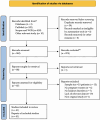Balance control and vestibular disorders in pregnant women: A comprehensive review on pathophysiology, clinical features and rational treatment
- PMID: 40405708
- PMCID: PMC12103688
- DOI: 10.1177/00368504251343778
Balance control and vestibular disorders in pregnant women: A comprehensive review on pathophysiology, clinical features and rational treatment
Abstract
During pregnancy, women experience substantial anthropometric, cardiovascular, hormonal and psychological changes that affect several organs involving the circulatory, respiratory, gastrointestinal, musculoskeletal, dermatological and sensory systems. The main aim of this review was to analyse the available literature on postural strategies throughout pregnancy in both static and dynamic conditions. The secondary aim was to assess and discuss the current knowledge regarding vestibular disorders during pregnancy. Pregnant women with vestibular disorders need appropriate and safe treatments to resolve or reduce symptoms without risks for mother and foetus. Our protocol was registered on PROSPERO (CRD42024622122). A literature search was conducted screening PubMed, Scopus and Web of Science databases. After duplicates removal and exclusion of records due to coherence with the inclusion/exclusion criteria, 41 articles relevant to the topic were examined. Although some studies claimed no changes in postural behaviour during pregnancy, most of the available evidence seems to demonstrate significant modifications in posture and balance metrics, with multiple mechanisms. Physiological changes that occur in the mother's body during pregnancy have been considered as a possible substrate for developing vestibular disorders. Dizziness and vertigo were reported in pregnancy in small, low-quality studies. Benign paroxysmal positional vertigo, vestibular neuritis, Ménière disease, vestibular migraine and vestibular schwannoma have all been documented in pregnant women. To overcome reported limitations, prospective studies, preferably multicentre and involving third-level audio-vestibular centres are mandatory in order to define rational diagnostic and treatment approaches for vestibular disorders to protect the safety of the mother and foetus.
Keywords: Pregnancy; balance; postural control; vertigo; vestibular disorders.
Conflict of interest statement
Declaration of conflicting interestsThe authors declared no potential conflicts of interest with respect to the research, authorship, and/or publication of this article.
Figures
Similar articles
-
Probabilities of Isolated and Co-Occurring Vestibular Disorder Symptom Clusters Identified Using the Dizziness Symptom Profile.Ear Hear. 2024 Jul-Aug 01;45(4):878-883. doi: 10.1097/AUD.0000000000001482. Epub 2024 Jan 30. Ear Hear. 2024. PMID: 38287481
-
[Progress concerning vertigo and dizziness. Now most patients can receive symptomatic relief].Lakartidningen. 1997 Jul 23;94(30-31):2639-42. Lakartidningen. 1997. PMID: 9273424 Review. Swedish. No abstract available.
-
Acute vestibulopathy.Curr Opin Neurol. 2001 Feb;14(1):11-20. doi: 10.1097/00019052-200102000-00003. Curr Opin Neurol. 2001. PMID: 11176212 Review.
-
Long-term course and relapses of vestibular and balance disorders.Restor Neurol Neurosci. 2010;28(1):69-82. doi: 10.3233/RNN-2010-0504. Restor Neurol Neurosci. 2010. PMID: 20086284 Review.
-
Subdiagnosis, but not presence of vestibular symptoms, predicts balance impairment in migraine patients - a cross sectional study.J Headache Pain. 2020 May 24;21(1):56. doi: 10.1186/s10194-020-01128-z. J Headache Pain. 2020. PMID: 32448118 Free PMC article.
References
-
- Dumke BR, Theilen LH, Shaw JM, et al. Sensory integration and segmental control of posture during pregnancy. Clin Biomech 2024; 115: 106264. - PubMed
-
- Sell TC. An examination, correlation, and comparison of static and dynamic measures of postural stability in healthy, physically active adults. Phys Ther Sport 2012; 13: 80–86. - PubMed
Publication types
MeSH terms
LinkOut - more resources
Full Text Sources
Medical


